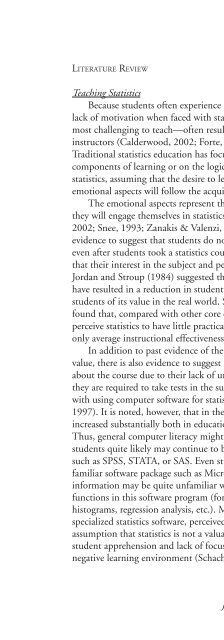WINTER 2012 - National Association of Schools of Public Affairs and ...
WINTER 2012 - National Association of Schools of Public Affairs and ...
WINTER 2012 - National Association of Schools of Public Affairs and ...
Create successful ePaper yourself
Turn your PDF publications into a flip-book with our unique Google optimized e-Paper software.
Pamela A. Gibson <strong>and</strong> Pamela Trump Dunning<br />
APPENDIX B<br />
Course Design Matrix<br />
The Course Design Matrix is a critical element is supporting the Commission<br />
on Colleges <strong>of</strong> the Southern <strong>Association</strong> <strong>of</strong> Colleges <strong>and</strong> <strong>Schools</strong> (SACS)<br />
requirements (<strong>and</strong> other specialized accreditations such as NASPAA <strong>and</strong><br />
AACSB) that all programs demonstrate assessment <strong>of</strong> educational objectives/<br />
student learning outcomes <strong>and</strong> use the assessment findings for continuing<br />
program improvements. Outcome-based learning enables administrative units to<br />
demonstrate that they are accomplishing their missions by achieving goals <strong>and</strong><br />
objectives related to their mission <strong>and</strong> continuously improving their operations<br />
<strong>and</strong> services along the way.<br />
TASK 1: LIST THE LEARNING OBJECTIVES<br />
All courses should be designed starting with <strong>and</strong> based on the learning objectives.<br />
Learning objectives for each course are specified by each discipline. You may<br />
have to “reorder” your list <strong>of</strong> objectives to fit a sequential course delivery. The<br />
instructor has the option <strong>of</strong> including additional objectives. The learning<br />
objectives lead to the desired course competency. All should be listed in the<br />
design matrix. Specifically, objectives are detailed statements <strong>of</strong> what the learners<br />
will be able to achieve or be able to demonstrate as a result <strong>of</strong> completing a<br />
course; they are statements <strong>of</strong> learner behavior. They describe the result <strong>of</strong> the<br />
learning process rather than what or how the learner will be taught.<br />
TASK 2: INDICATE THE COURSE MODULE OR WEEK<br />
Each learning objective should have an identifiable “module” <strong>of</strong> instruction.<br />
Normally this module will equate to a specific week that the class meets. Because<br />
each learning objective requires support in terms <strong>of</strong> course material, instructional<br />
strategy, <strong>and</strong> assessment, it should be organized into a deliverable module.<br />
TASK 3: INDICATE THE COURSE CONTENT TO SUPPORT EACH MODULE<br />
Each learning objective should have identifiable course materials or content to<br />
support the instruction. Normally this will equate to a chapter in the text, lecture<br />
notes, video clips, exercises, cases, slides, or guidelines prepared by the instructor.<br />
TASK 4: INDICATE THE INSTRUCTIONAL STRATEGY TO SUPPORT THE LEARNING OBJECTIVE<br />
Each objective should have a specific instructional strategy. This refers to<br />
your method <strong>of</strong> instruction such as lecture, class discussion, discussion board<br />
activities, exercises, computer simulations, case analysis, <strong>and</strong> so forth.<br />
TASK 5: INDICATE THE METHOD OF ASSESSMENT<br />
Each learning objective needs to have some measure <strong>of</strong> assessment to ensure that<br />
226 Journal <strong>of</strong> <strong>Public</strong> <strong>Affairs</strong> Education

















